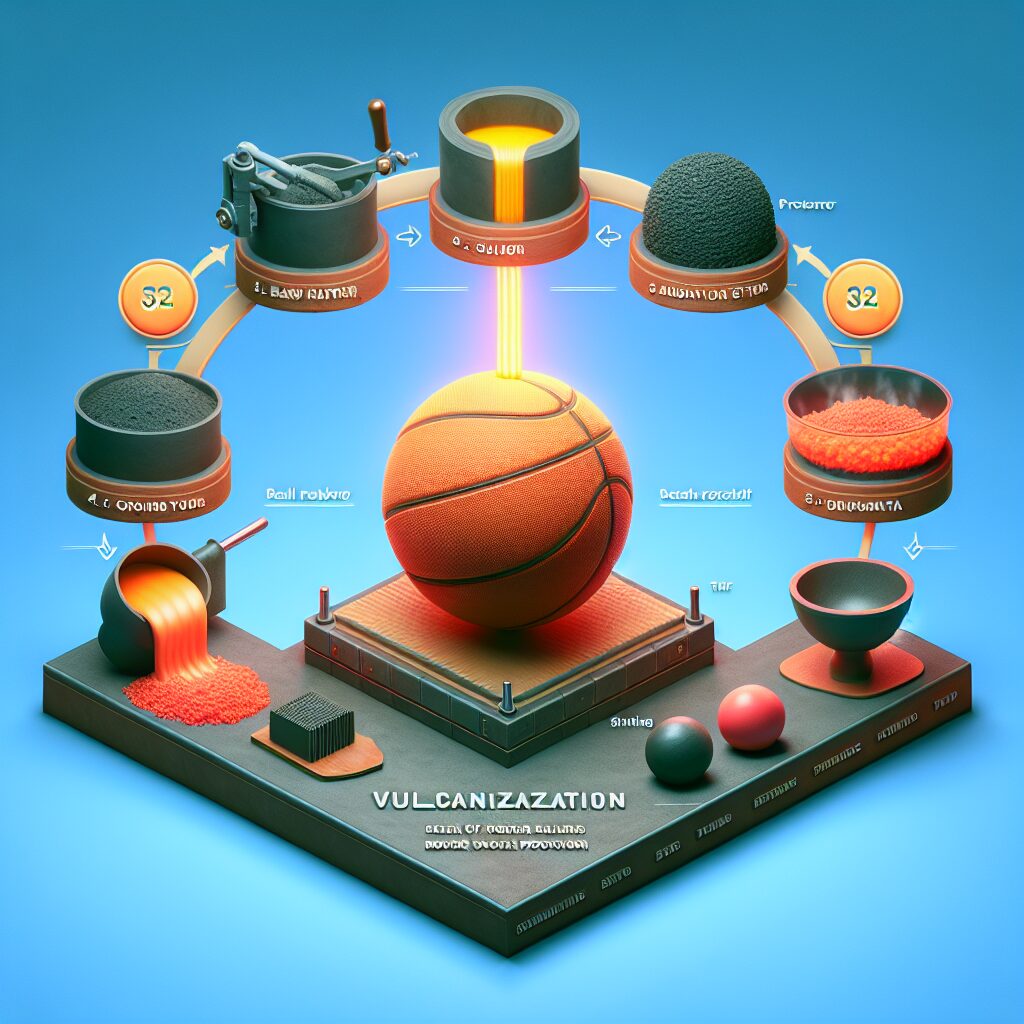Rubber vulcanization plays a crucial role in ball production, ensuring the durability and performance of the final product. But what exactly is rubber vulcanization? In simple terms, it is a process of combining rubber with other chemicals to enhance its properties, such as strength, elasticity, and resistance to wear and tear. This unique process involves the use of heat and pressure to create strong cross-links between rubber molecules, resulting in a more robust and reliable material.
The steps of rubber vulcanization in ball production have various significant impacts. Firstly, it enhances the strength and durability of the rubber, making it suitable for rigorous use in sports or industrial settings. This means that the balls will withstand the intense impact and friction they encounter during gameplay, and last longer under challenging conditions. Additionally, vulcanization improves the elasticity of the rubber, ensuring the balls can bounce back effectively, providing a consistent and enjoyable playing experience.
Moving on to the key takeaways of this article, let’s explore the different stages of rubber vulcanization in ball production. We will delve into the preparation of the rubber compound, the application of heat and pressure for vulcanization, and the post-vulcanization processes that add the finishing touches to the balls. By understanding these crucial steps, manufacturers can create high-quality balls that offer superior performance, longevity, and reliability. So, let’s dive further into the fascinating world of rubber vulcanization in ball production and uncover its secrets.
Key Takeaways
1. Rubber vulcanization is a crucial process in ball production that involves heating the rubber compound while adding sulfur to improve its durability and elasticity.
2. The first step in the vulcanization process is preheating the raw rubber material to soften it, allowing for easy mixing with other ingredients.
3. The rubber compound is then mixed with sulfur and other chemicals, such as accelerators and activators, to promote cross-linking of rubber polymer chains during vulcanization.
4. After mixing, the rubber compound is shaped into balls using molds and subjected to heat and pressure in an autoclave to initiate the vulcanization process.
5. The vulcanization time and temperature must be carefully controlled to ensure proper curing of the rubber, resulting in superior quality balls that exhibit desired hardness, rebound, and durability.
What are the Step-by-Step Procedures for Rubber Vulcanization in Ball Production?
Section 1: Rubber Mixing
During the initial phase of ball production, rubber mixing plays a crucial role. The process involves combining various rubber compounds and additives to form a homogeneous mixture. This step ensures that the rubber possesses the necessary properties required for vulcanization.
Section 2: Mold Preparation
Once the rubber mixture is ready, the next step is mold preparation. In this stage, molds specifically designed for ball production are cleaned and coated with release agents. The release agents prevent the rubber from sticking to the mold and ease the demolding process later on.
Section 3: Molding
After the mold preparation, the rubber mixture is injected or poured into the molds. The molds are then closed tightly, ensuring no air gaps or leaks. The rubber takes the shape of the mold cavity, forming the desired ball shape.
Section 4: Vulcanization Process
The most critical phase in ball production is the vulcanization process. Vulcanization is a heat-induced chemical reaction that transforms the rubber from a soft, malleable state to a durable, elastic state. The molded rubber balls are loaded into an autoclave or vulcanization chamber, which provides controlled temperature and pressure conditions necessary for successful vulcanization.
Section 5: Vulcanization Parameters
To ensure optimal vulcanization, several parameters need consideration. Temperature, time, and pressure settings are carefully controlled during vulcanization. The temperature should be set based on the rubber compound used, while the time and pressure depend on the desired hardness and elasticity of the ball.
Section 6: Cooling and Demolding
Once the vulcanization process is complete, the rubber balls undergo a cooling phase. Cooling helps the rubber solidify and retain its shape. After cooling, the molds are opened, and the rubber balls are demolded. The release agents applied earlier facilitate easy separation of the ball from the mold.
Section 7: Post-Vulcanization Treatment
After demolding, the rubber balls might undergo additional treatments depending on the desired characteristics. These treatments can include washing, trimming excess rubber, and surface treatment for enhanced grip or durability.
Section 8: Quality Control
To ensure consistent quality, thorough quality control measures are implemented throughout the entire rubber vulcanization process. Inspections are conducted to check for defects, dimensional accuracy, hardness, and other required specifications.
Tips for Successful Rubber Vulcanization in Ball Production:
1. Follow the recommended rubber compound proportions and additives for optimal mixing.
2. Ensure the molds are properly cleaned and coated with release agents before molding.
3. Maintain precise temperature, time, and pressure settings during vulcanization.
4. Allow sufficient cooling time before demolding to avoid deformation or surface imperfections.
5. Conduct comprehensive quality control checks to maintain product integrity and meet desired specifications.
FAQ
1. What is rubber vulcanization in ball production?
Rubber vulcanization is a process in ball production where raw rubber is heated with various chemicals to create a chemical reaction that transforms the rubber into a more durable and resilient material.
2. Why is rubber vulcanization important in ball production?
Rubber vulcanization is crucial in ball production as it significantly enhances the physical properties of rubber, such as its elasticity, thermal stability, and resistance to abrasion. It ensures that the balls produced are durable and able to withstand the rigorous demands of various sports.
3. What are the steps involved in rubber vulcanization in ball production?
The steps of rubber vulcanization in ball production typically include mixing the raw rubber with vulcanizing agents, molding the mixture into the desired shape, heating it at a specific temperature, maintaining the temperature for a certain period, and finally cooling and removing the ball from the mold.
4. What chemicals are commonly used for rubber vulcanization in ball production?
Common chemicals used for rubber vulcanization in ball production include sulfur, accelerators, and activators. Sulfur acts as a cross-linking agent, while accelerators and activators help in speeding up the vulcanization process.
5. How does heat affect the rubber during vulcanization in ball production?
Heat plays a critical role in rubber vulcanization as it initiates and accelerates the vulcanization reaction. The heat causes the sulfur to melt and react with the rubber, forming strong cross-links between polymer chains, resulting in improved strength and stability.
6. Are there any environmental concerns associated with rubber vulcanization in ball production?
Rubber vulcanization in ball production can involve the use of certain chemicals that may have environmental impacts if not handled properly. However, modern production processes and regulations ensure that these chemicals are used responsibly and disposed of safely, minimizing any potential environmental concerns.
7. Can rubber vulcanization affect the performance of the ball?
A properly vulcanized rubber ball tends to have enhanced performance compared to non-vulcanized ones. Vulcanization improves the elasticity, durability, and resistance to wear and tear of the ball, allowing it to maintain its shape and performance characteristics over time.
8. Is rubber vulcanization a time-consuming process?
Rubber vulcanization in ball production can vary in duration depending on factors such as the type of rubber, desired properties, and the vulcanization method used. Some vulcanization processes can be completed within minutes, while others may require several hours or longer.
9. Can the vulcanization process be customized for specific ball requirements?
Yes, the vulcanization process can be tailored to meet specific ball requirements. By adjusting factors such as temperature, duration, and the composition of vulcanizing agents, manufacturers can modify the final properties of the ball, such as hardness, bounce, and grip.
10. Is rubber vulcanization used only in ball production?
No, rubber vulcanization is not limited to ball production. It is a widely used process in the manufacturing of various rubber products, including tires, hoses, gaskets, shoe soles, and many other rubber-based items.
Final Thoughts
The steps of rubber vulcanization in ball production are crucial in creating high-quality and long-lasting rubber balls for sports and recreational activities. This process ensures that the rubber material is transformed into a more durable and resilient form, enhancing its physical properties and performance. By understanding the intricacies of rubber vulcanization, manufacturers can create balls that offer superior bounce, grip, and durability, thereby enhancing the overall playing experience.
Furthermore, as technology continues to advance, the vulcanization process becomes more efficient, environmentally friendly, and customizable. This allows manufacturers to produce balls with specific characteristics tailored to different sports and player preferences. The art of rubber vulcanization in ball production combines scientific principles with manufacturing expertise, resulting in high-quality balls that withstand the demanding conditions of various sports while providing optimal performance and enjoyment for users.




